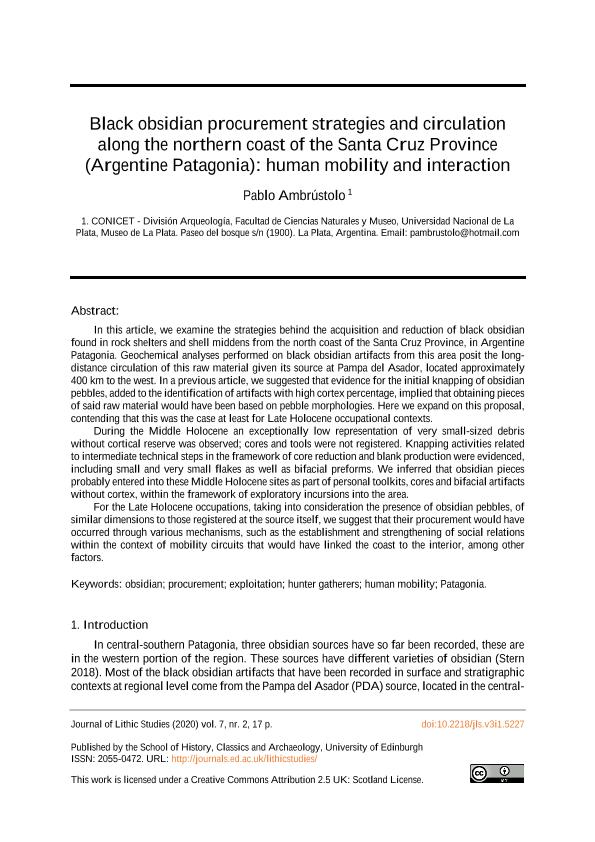Mostrar el registro sencillo del ítem
dc.contributor.author
Ambrustolo, Pablo

dc.date.available
2021-06-23T17:22:41Z
dc.date.issued
2020-09
dc.identifier.citation
Ambrustolo, Pablo; Black obsidian procurement strategies and circulation along the northern coast of the Santa Cruz Province (Argentine Patagonia): human mobility and interaction; University of Edinburgh; Journal of Lithic Studies; 7; 2; 9-2020; 1-17
dc.identifier.issn
2055-0472
dc.identifier.uri
http://hdl.handle.net/11336/134760
dc.description.abstract
In this article, we examine the strategies behind the acquisition and reduction of black obsidian found in rock shelters and shell middens from the north coast of the Santa Cruz Province, in Argentine Patagonia. Geochemical analyses performed on black obsidian artifacts from this area posit the long-distance circulation of this raw material given its source at Pampa del Asador, located approximately 400 km to the west. In a previous article, we suggested that evidence for the initial knapping of obsidian pebbles, added to the identification of artifacts with high cortex percentage, implied that obtaining pieces of said raw material would have been based on pebble morphologies. Here we expand on this proposal, contending that this was the case at least for Late Holocene occupational contexts.During the Middle Holocene an exceptionally low representation of very small-sized debris without cortical reserve was observed; cores and tools were not registered. Knapping activities related to intermediate technical steps in the framework of core reduction and blank production were evidenced, including small and very small flakes as well as bifacial preforms. We inferred that obsidian pieces probably entered into these Middle Holocene sites as part of personal toolkits, cores and bifacial artifacts without cortex, within the framework of exploratory incursions into the area.For the Late Holocene occupations, taking into consideration the presence of obsidian pebbles, of similar dimensions to those registered at the source itself, we suggest that their procurement would have occurred through various mechanisms, such as the establishment and strengthening of social relations within the context of mobility circuits that would have linked the coast to the interior, among other factors.
dc.format
application/pdf
dc.language.iso
eng
dc.publisher
University of Edinburgh
dc.rights
info:eu-repo/semantics/openAccess
dc.rights.uri
https://creativecommons.org/licenses/by/2.5/ar/
dc.subject
OBSIDIAN
dc.subject
PROCUREMENT
dc.subject
EXPLOITATION
dc.subject
HUNTER GATHERERS
dc.subject.classification
Arqueología

dc.subject.classification
Historia y Arqueología

dc.subject.classification
HUMANIDADES

dc.title
Black obsidian procurement strategies and circulation along the northern coast of the Santa Cruz Province (Argentine Patagonia): human mobility and interaction
dc.type
info:eu-repo/semantics/article
dc.type
info:ar-repo/semantics/artículo
dc.type
info:eu-repo/semantics/publishedVersion
dc.date.updated
2021-06-22T19:05:33Z
dc.journal.volume
7
dc.journal.number
2
dc.journal.pagination
1-17
dc.journal.pais
Reino Unido

dc.journal.ciudad
Edinburgh
dc.description.fil
Fil: Ambrustolo, Pablo. Universidad Nacional de La Plata. Facultad de Ciencias Naturales y Museo. División Arqueología; Argentina. Consejo Nacional de Investigaciones Científicas y Técnicas. Centro Científico Tecnológico Conicet - La Plata; Argentina
dc.journal.title
Journal of Lithic Studies
dc.relation.alternativeid
info:eu-repo/semantics/altIdentifier/url/http://journals.ed.ac.uk/lithicstudies/article/view/5227
Archivos asociados
